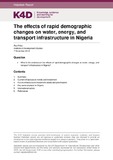The Effects of Rapid Demographic Changes on Water, Energy, and Transport Infrastructure in Nigeria
Abstract
Nigeria has historically under-invested in its infrastructure. The infrastructure deficit cuts across all sectors, but it is most severe for access to water and sanitation. Although Nigeria is expected to improve levels of access to basic infrastructure by 2040, rapid population growth (especially its urban population which is growing much faster than its rural population) will magnify its current infrastructure deficit challenge and access levels will continue to lag behind average levels from its global income peers (Bello-Schünemann and Porter, 2017). On its current development trajectory, it is unlikely that Nigeria will meet universal access for clean water, improved sanitation and electricity, as envisioned in the Sustainable Development Goals (SDGs). This review draws heavily on the report by Bello-Schünemann and Porter (2017), which provides an in-depth look at infrastructure in Nigeria until 2040. This review mostly draws on grey literature from international financial and consultancy institutions such as the World Bank, Deloitte, and McKinsey. This is because much of the information available is angled at promoting investment into Nigeria – especially financing of large-scale infrastructure projects. Academic literature was also included. The literature notes that it is difficult to get hold of reliable data on infrastructure spending in Nigeria. The figures from different sources tend to vary greatly and are often not comparable, as they can be based on different definitions of infrastructure and data sources.
Citation
Price, R.A. (2019). The effects of rapid demographic changes on water, energy, and transport infrastructure in Nigeria. K4D Helpdesk Report. Brighton, UK: Institute of Development Studies.Is part of series
K4D Helpdesk Report;700Rights holder
© DFID - Crown copyright 2019Collections
- K4D [937]

